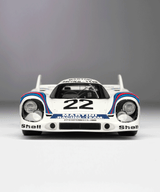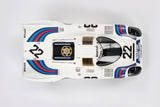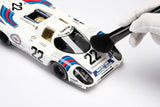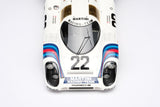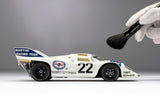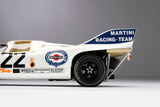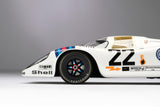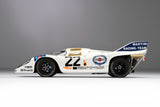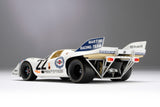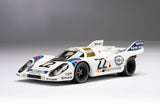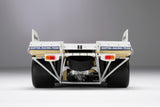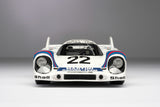Arguably one of the most iconic race cars in the history of motorsport, the Porsche 917K’s conception stemmed from an unexpected change to Commission Sportive Internationale, then the independent competition arm of the FIA, sanctioning rules. After the 1967 race season, it was announced that all future prototype engines would be limited to 3.0 litres, in order to reduce the speeds generated at the fast endurance tracks, whilst also enticing manufacturers who were already building three-litre Formula One engines into endurance racing. Well aware that few manufacturers were up to the challenge immediately, the CSI also announced a new Group 4 sports car series, which allowed engine displacements of up to 5.0 litres, but required at least 25 units be produced for homologation. Porsche, already hard at work polishing its 3.0-litre race car, the 908, stunned the world when it unveiled a second prototype race car aimed at the Group 4 category: the 917. Despite the FIA’s doubts, Porsche presented the FIA with 25 units just three weeks after the 917’s debut at the Geneva Motor Show in March of 1969.
Powering the early 917 was a 4.5-litre Flat-12 engine, designed by the noted Porsche engineer Hanz Mezger. To curtail development costs, the engine borrowed heavily from its 3.0-litre counterpart found in the Porsche 908. The 1969 race engines produced 580 bhp and 376 lb-ft of torque. Later models had the option to run larger-displacement engines of 4.9, 5.0 and eventually 5.4 litres, each providing a corresponding bump in performance. The Flat-12 would go on to become the 917’s most defining trait.
While the engine was an immediate success, the car’s body and aerodynamics were anything but. Early tests were worrisome. The car wandered heavily under braking and was diabolical in high-speed turns. None of the regular Porsche drivers wanted to race it. But the engineers at Porsche soldiered on, eventually adding wider rear wheels and a few other changes that made the 917 into a more controllable machine. Short and long-tail versions of the car were developed, but while the 917 long-tail is a thing of beauty, the shape made famous by a flurry of victories is the short version, better known as the 917K, for “Kurtz.”
The 917K did not have to wait long for success. On its public debut at the 1970 Daytona 24 Hours, John Wyer's Gulf-sponsored team finished 1-2 in the race, with the winning car breaking the distance record by 190 miles. This victory effectively began the 917K's domination of the World Sportscar Championship for the next two seasons. Porsche’s first overall victory at the 24 Hours of Le Mans soon followed, a momentous occasion for the German marque, but only one of many more to follow. Triumphs that year came quickly and resoundingly and, in total, the 917K’s first full year of competition would bring seven major victories. 1971 was no different, with six major victories topped by another overall win at Le Mans. Later that year, development of the Can-Am version would start, a car so dominant that the series lost popularity in the United States, never to return.
Today, the 917K is revered as one of the most iconic race cars of all time. It was the car that brought Porsche its first overall victory at the world’s most gruelling race, and the car that would go on to set one of the most impressive records of dominance in prototype racing series the world has ever seen. If its racing achievements alone were not enough, the car would go on to be immortalised on the big screen by Steve McQueen in the film ‘Le Mans’.
This fine 1:18 scale model of the Porsche 917K is based on the #22 car driven to victory by Dutch driver Gijs van Lennep and Austrian racer Helmut Marko at the 24 Hours of Le Mans in 1971. With the ban for over 3.0 litre engine displacements imminent, the race turned into quite the swansong; a long, fast track and extended good weather produced the fastest race in the event's history to date. There were not many accidents this year, but many cars were delayed or forced to retire due to mechanical problems so only twelve cars were classified as finishers. The Team Martini Porsche at the front of these finished two laps ahead of its rival John Wyer Porsche and an incredible 29 laps (386km) ahead of the third place Ferrari. The two Porsches were the first cars to cover over 5000km at Le Mans, a record that would stand for 39 years, cementing the 917K’s dominance over this era of motorsport.
This model has been handcrafted and finished in our workshops with the co-operation and assistance of Porsche regarding original finishes, materials, archive imagery and drawings. The use of supremely accurate digital scanning of the original car has allowed us to perfectly recreate every detail at scale. Furthermore, it has undergone detailed scrutiny by both engineering and design teams to ensure complete accuracy of representation.













